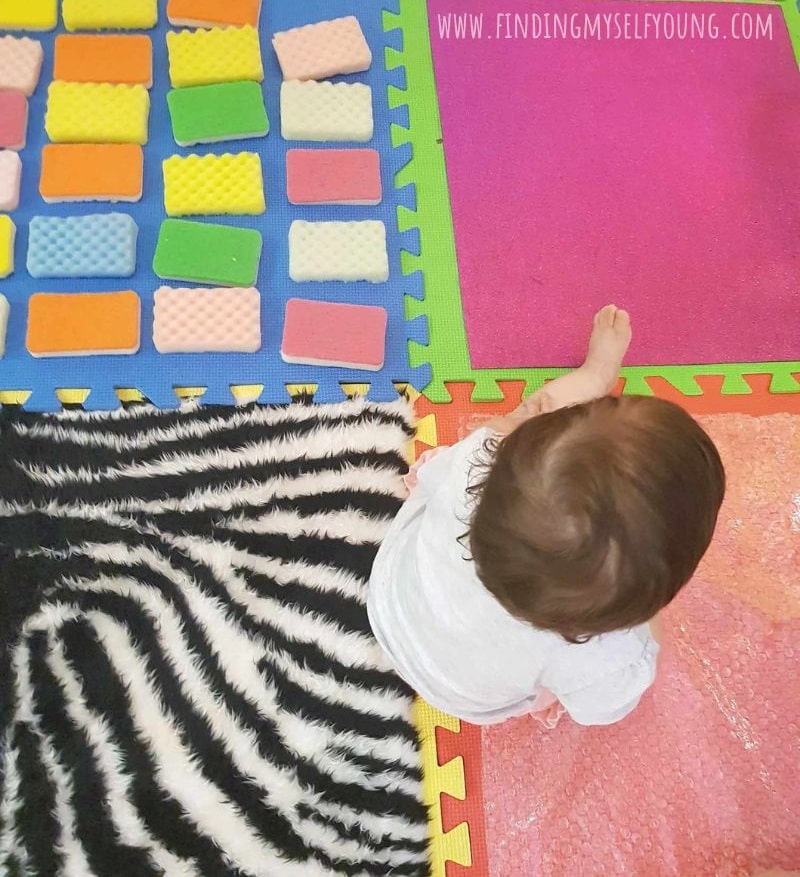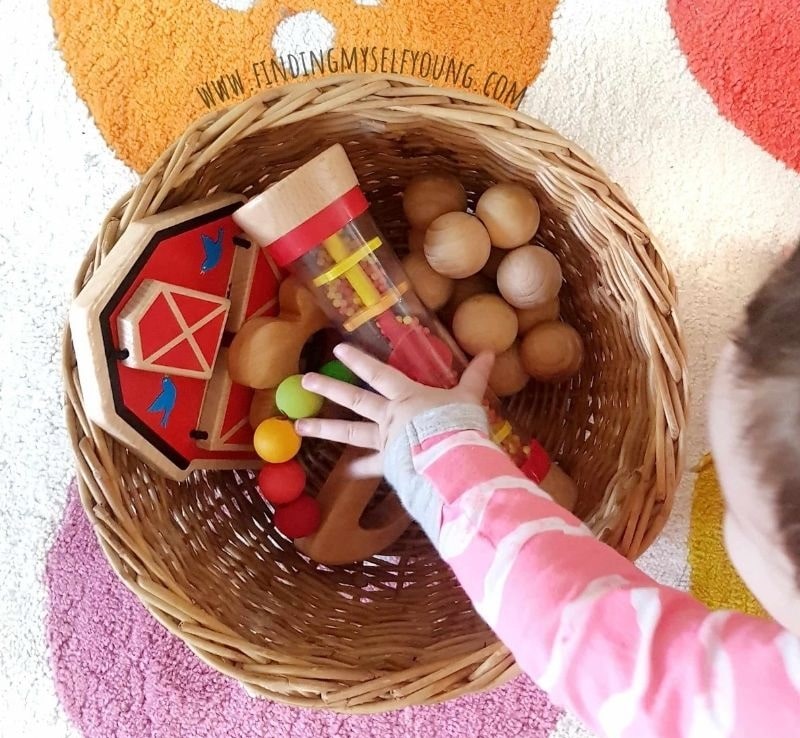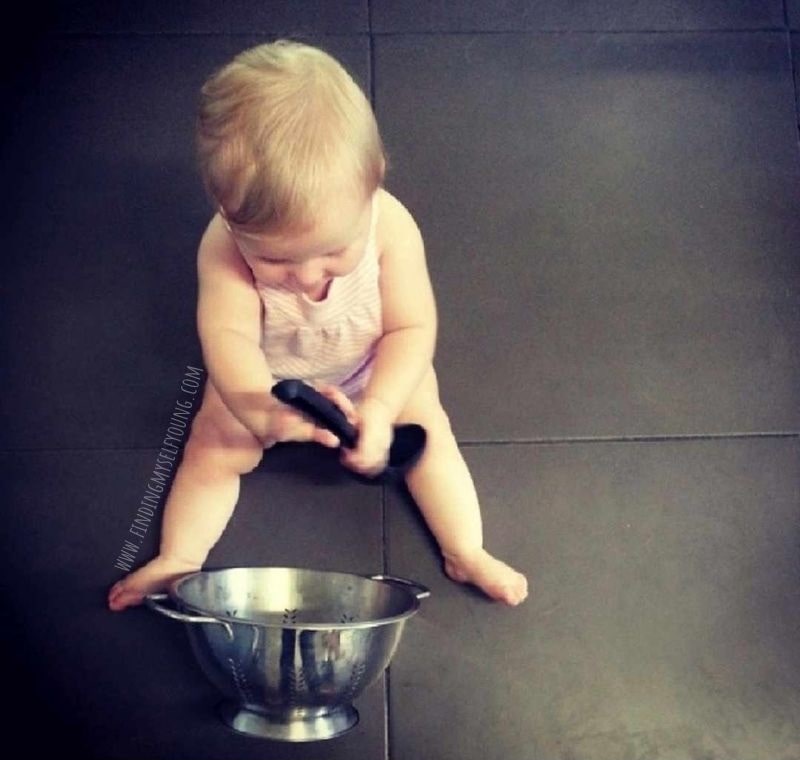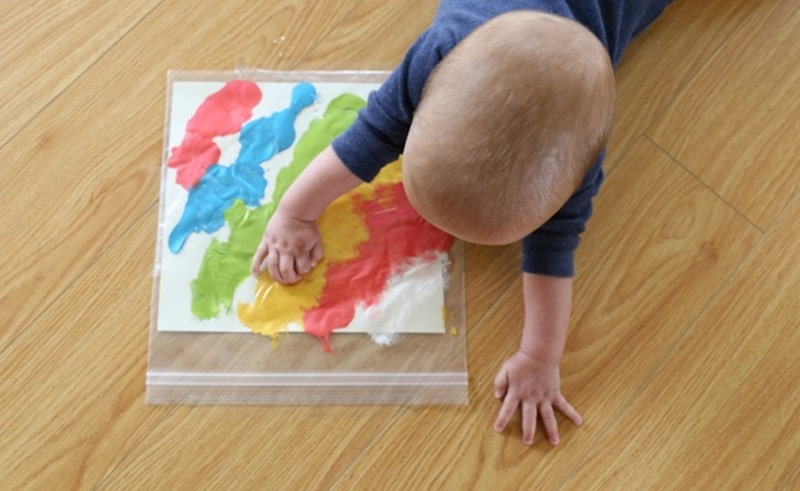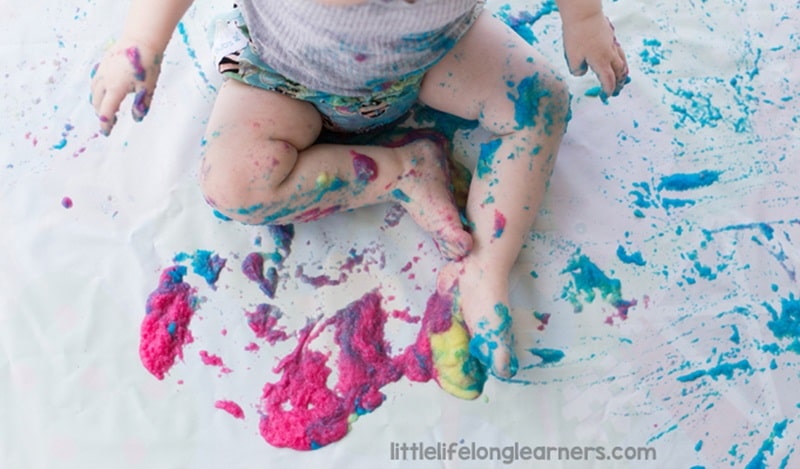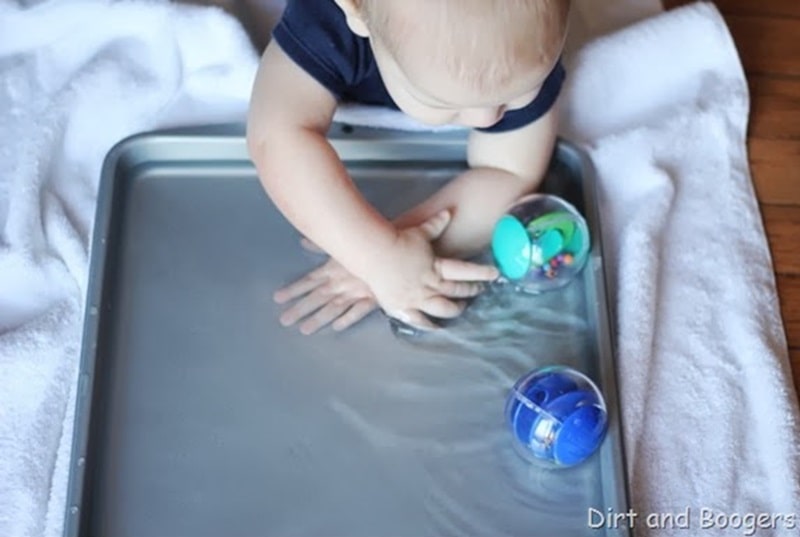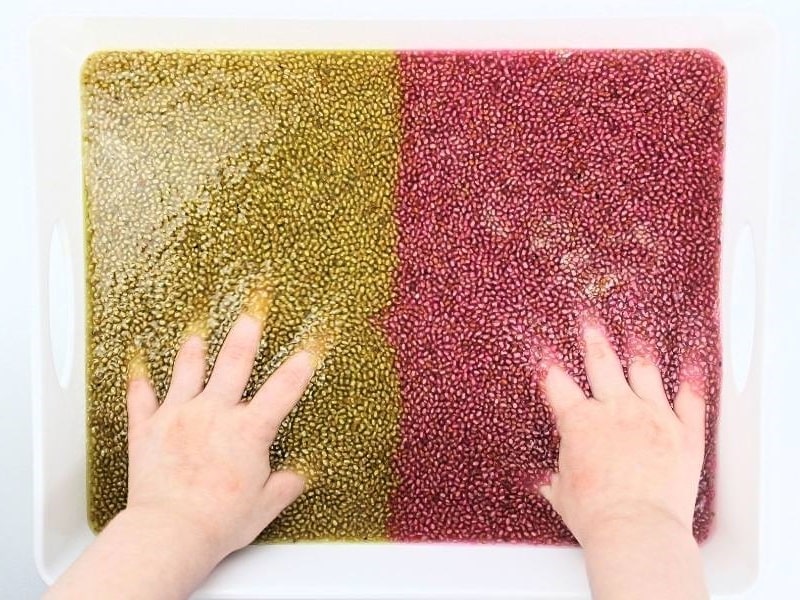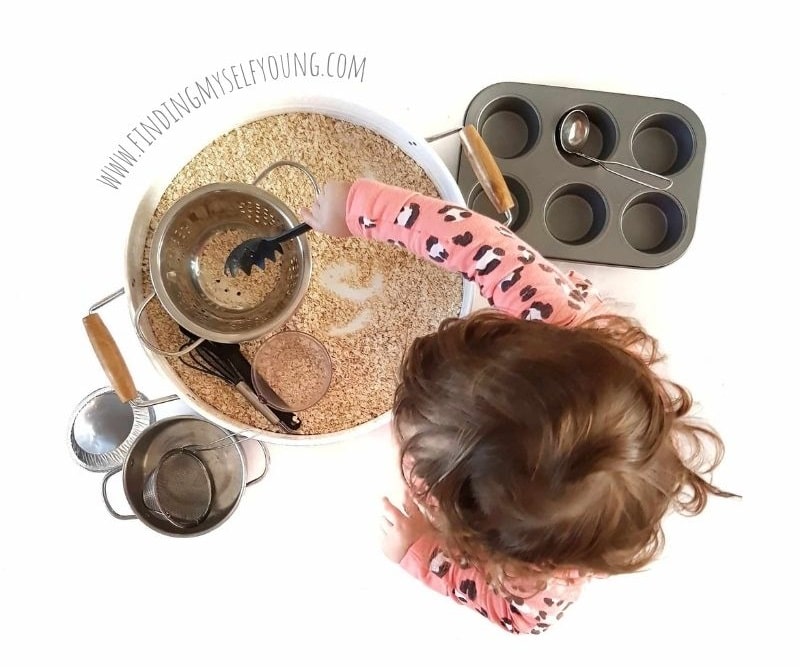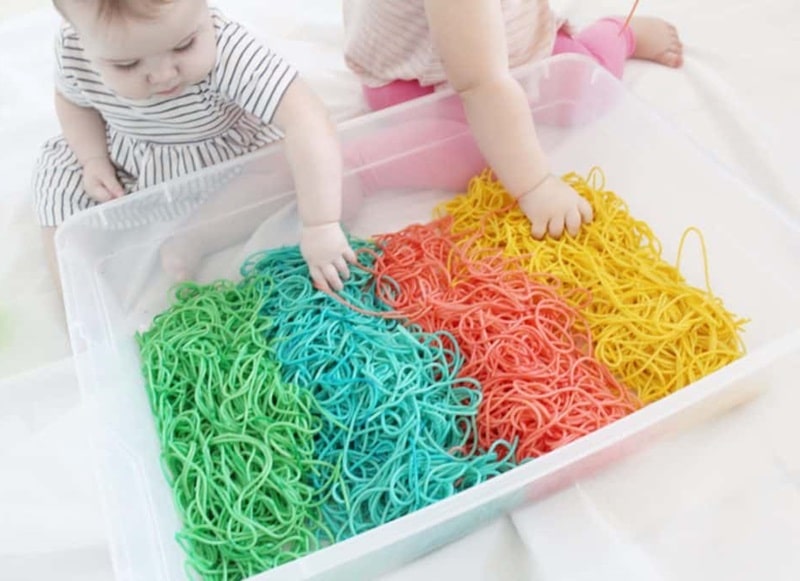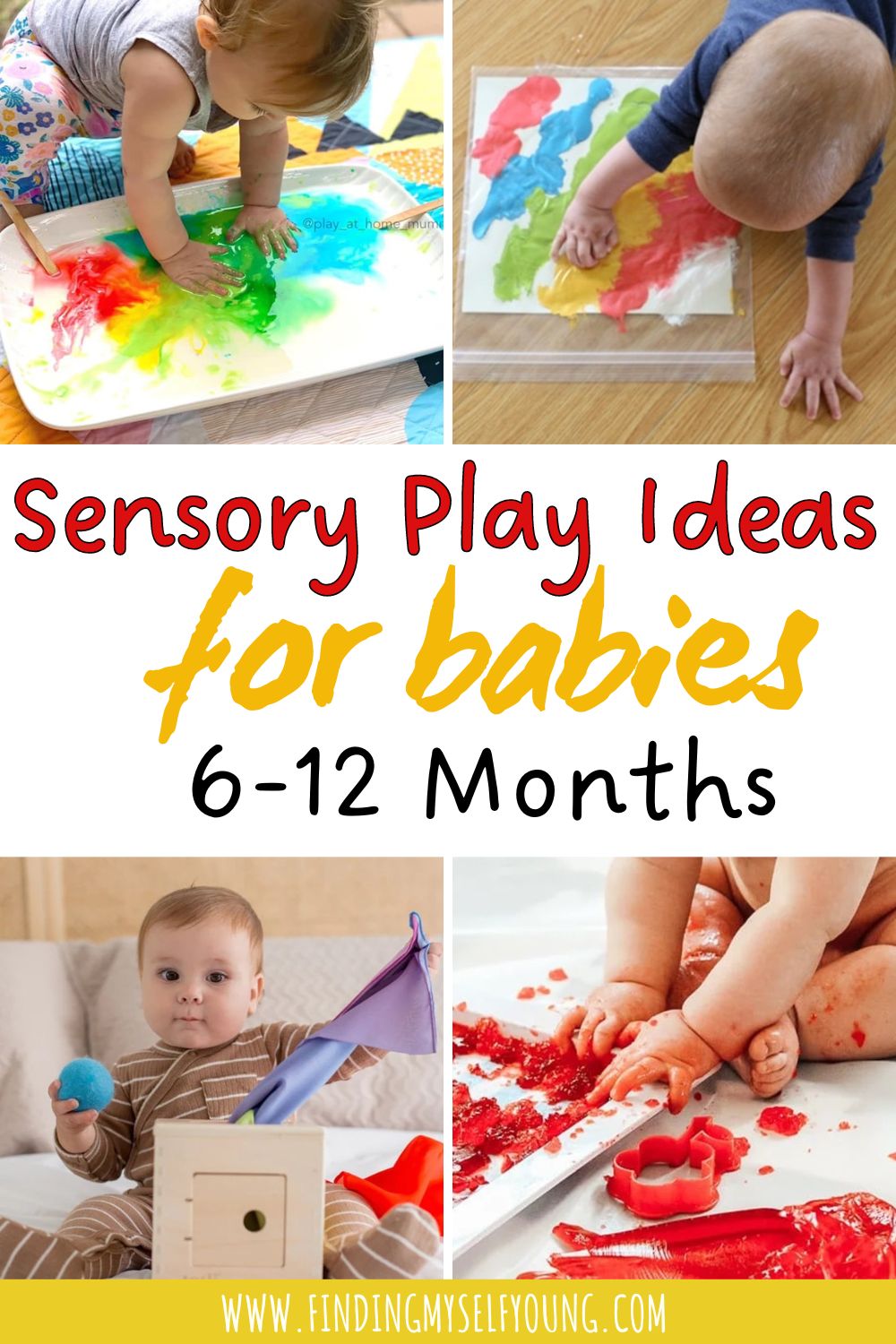By 6 months old, babies are learning and developing new skills at a more rapid rate than before and can interact with the world around them a lot more. They become more mobile as they learn to sit, crawl and eventually walk and they can properly grasp, hold and move objects around. Babies also typically start solids around 6 months which opens up a world of opportunities with taste safe sensory play that didn't exist previously.
All of these factors mean babies over 6 months can explore using their senses through play in even more ways. Below is a list of sensory play ideas for babies from 6-12 months old including ideas to delight their senses incorporating sight, sound, touch and taste.
SENSORY PLAY FOR BABIES 6-12 MONTHS OLD
Sensory play will help babies develop cognitively, socially and emotionally. By helping them to discover different textures, colours, sounds and tastes you're helping develop their visual perception, spatial awareness, hand/eye coordination, fine motor skills, ability to self regulate their emotions and understand object permanence.
Once babies have started weaning and been introduced to foods you can start including taste safe sensory play options. Taste safe does not mean that we encourage them to eat the sensory bin contents however, it simply means that they're made with taste safe ingredients and will not harm baby if they decide to explore with their mouths {as babies do}.
Please remember do not attempt any of the taste safe sensory play ideas in this post unless your baby has been previously exposed to the food items included to ensure there are no allergies. You don't want fun messy play to turn into an allergic reaction.
All sensory activities should be done under direct adult supervision.
Shop sensory play items for 6 months + in my Amazon store here.
DIY sensory mats
Use the large baby foam play mat squares that interlock to create your own sensory mat by attaching different sensory items to each square. You can use pieces of fabrics such as velvet, faux fur, satin, items like sponges or shower puffs and even recycled material like cardboard or bubble wrap to create different textures on each square section. You can also change the configuration of the mat regularly as each piece can interlock in various positions.
Make sure each item is securely attached to the mat and dried before allowing baby to play with it, I recommend using super glue or gorilla fabric glue {depending on what items you're attaching}. Regularly inspect the mats to check if any pieces may be coming loose or deteriorating. Discard or replace any fabric or mat pieces that have rips or loose pieces that may pose a choking risk.
Treasure baskets
One of my favourite ways to present items for my girls when they were young was in a treasure basket. A treasure basket {also known as a discovery basket} is literally a shallow basket filled with items "treasures" for them to pick up and discover.
You can fill a treasure basket with any baby safe items you like. The one above I just put together a selection of baby wooden toys that were safe for her to hold, shake, mouth and play with. We've done numerous treasure baskets including themed ones like sensory balls, colour baskets, texture baskets, musical instruments and more.
Heuristic play
Heuristic play is allowing babies and toddlers to explore everyday items under supervision. This can be similar to discovery baskets as it's all about letting the child explore the items in their own way and discover how to play with them using their imagination - except you don't use actual toys.
My girls favourite form of heuristic play was getting hold of pots and pans and plastic spoons to bang and go crazy making music. Has your child ever got into the plastics cupboard? That's heuristic play too.
Muffin tin sound play
You can also help your baby to explore sound with a muffin tin and various items. Set out a different toy or item into each hole of the muffin tin and then encourage baby to tap them onto the muffin tray to see what different sounds they make.
Use items made from a range of different materials, shapes and weights so they have to grasp them all differently to hold them properly. The difference in materials i.e. wooden and plastic will also result in different sounds against the metal of the muffin tin.
Make sure you're supervising baby as they play and discourage them from putting any items in their mouth as items smaller than the muffin tin holes could pose a choking risk.
Sensory blocks
A fun way for babies to explore textures and build their fine motor skills at the same time is to use sensory blocks. Sensory blocks are wooden blocks with different sensory materials either embedded into them or attached to the outside. Babies can grasp them and run their fingers over the different textures and they can also use them to build by stacking them.
 |
| Image: The Wooden Story |
Sensory blocks are a great toy to add to a busy bag if you need to go to appointments or are travelling as they're portable and won't take up too much space. You can also get silicone sensory blocks, or make your own DIY sensory blocks.
Object permanence box
Babies don't understand object permanence {that items and people still exist even when they can't see them} which is why they often cry when you go out of sight. To help them understand this concept you can play games like peek-a-boo and use simple tools such as an object permanence box.
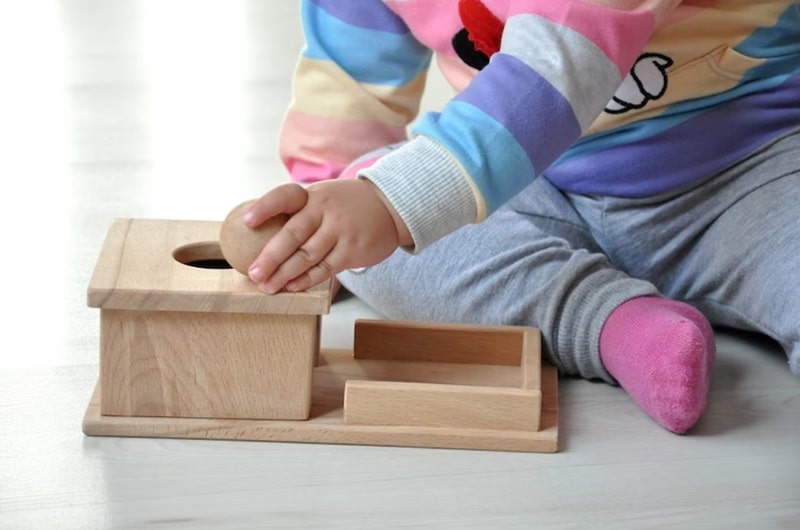 |
| Image: Montessori Products |
An object permanence box is a simple tool used in Montessori to teach young children that an object can disappear, but it will come back again. This is done by posting a ball into a box and then it rolls back out the side of the box. You can get many different wooden object permanence boxes from Etsy or Amazon, or you can make your own DIY version with a cardboard box.
Pulling scarves
In our house we love repurposing anything to make DIY toys and that includes the cat toy below. After the cats lost interest I kept it because I just knew it would come in handy in so many ways. I filled all of the holes with different coloured play silks for my daughter to discover and she loved pulling them out and pushing them back in the holes.
If you don't have a random cat toy laying around, and let's face it not many people do, don't worry you can get the same effect in many ways. Empty tissue boxes or wipes packets with flap lids make great posting boxes, just fill them with scarves and babies will love pulling them out and stuffing them back in. You can also fill an o-ball with scarves for them to pull out.
Totli box
The Totli box has been specially designed by child development experts bringing together Montessori elements and occupational therapy to help babies explore containment whilst learning many other skills. The Totli box includes a coin drop slot, ball drop, a scarf pull section and a flap door and comes with coins, balls and play silks to use with the box.
 |
| Image: Totli |
As they put balls and coins into the box then pull them out of the flap door, babies are learning about object permanence and coordination as they push, post and pull items into the slots. Pulling the scarves out of the slot is also a fun way to experience soft and colourful textures and they can post them back into the box as well.
The Totli box offers visual and tactile stimulation using items of varying weights, materials, textures, colours and sizes. Each movement also helps baby build their fine motor skills and hand/eye coordination. You can use the code FMY10 to save 10% off all Totli products {excluding sale items}.
Sensory tunnel
Once your baby is able to confidently crawl you can set up a DIY sensory tunnel using an old cardboard box big enough for them to crawl through. Use some colourful tights or socks to hang from the roof of the box so baby can crawl through them as they navigate the tunnel. You could also use scarves, ribbons, strips of different fabric, or even poke fairy lights through the roof.
Crawling through the tunnel is great for their gross motor development and they'll also get sensory input from the bright colours and different textures of the hanging fabrics and the feel of the cardboard as they crawl. Make sure your items are properly secured from the top of the box as babies will most likely try to pull them.
DIY texture book
Make your own DIY texture flap book for baby using fabric scraps of different textures, colours and patterns. Cut each piece to the same size with pinking shears to stop them from fraying around the edges.
Flicking through the fabric pages of the book will help babies develop fine motor skills as they grasp each piece of fabric and they'll get tactile and visual sensory input while touching and exploring the fabric pieces.
Touch and feel books
If you don't want to make a DIY book, there's plenty of touch and feel books you can purchase that have different textures for children to touch as they flip through the books. Our favourites are the That's not my.... series of books because they use a variety of different fabrics and the story describes how each one feels as you're reading it which is a great way to build vocabulary.
Mess free painting
Sensory play can also involve making art. If you want to introduce baby to painting, but don't want them getting messy or risk them ingesting the paint, set up this mess free painting activity for babies using a plastic zip lock bag to contain the paint.
You can do this painting on the floor during tummy time {as shown above}, taped to the wall while sitting, or taped to the highchair tray. Baby can squish and press on the paint to smudge it across the paper and create a unique artwork that can be displayed once dry, without being exposed to the actual paint.
Edible baby paint
On the other hand if you're not adverse to mess and happy for baby to fully explore paint, then you can make your own DIY edible baby paint and let the mess unfold knowing that it's completely ok if baby has a taste test. If you want to limit the mess set it up on a highchair tray, or you can have some full body fun on a plastic play mat {and a bath afterwards}.
You can make taste safe baby paint with a number of different foods including flour, cornflour, baby yoghurt or rice cereal mixed with water and food colouring. Make sure baby has been exposed to the food you choose before using it to make paint to ensure there are no allergies.
Water play
While it seems extremely simple to us as adults, playing with water is a great way to expose babies to lots of learning opportunities. When they touch the water they'll experience wet and cold {or warm}, when they splash the water they can see cause and effect visually as the water moves and splashes. If you add a few floating toys {bath toys are great for this} then they'll also be working on eye tracking watching them float around the tray and it'll encourage them to reach and grasp for the toys.
An easy way to set up water play for babies is by using a shallow tray on a towel or mat in front of baby. They can be on their tummy {with or without a tummy pillow under them}, or sitting {only if they can already sit comfortably unassisted}. Make sure the water temperature isn't too hot or cold and don't ever leave them unsupervised.
Jello sensory tub
Jello {jelly} is a super fun texture for babies to explore as it's cool and solid, but also soft and squishy. You can make a jello sensory bin simply using a packet of jello and water, however if you want to avoid the sugar {just in case they taste test} then you can get sugar free jello, or use plain gelatin and liquid food colouring or natural colouring which will create the same result.
Babies will love being able to grab, squeeze, squish and poke the jelly and notice how the texture and temperature of it changes as they play. Be warned though this one has the potential to get very messy and a bit sticky so be prepared for a bath afterwards.
You can also add in large animal figurines or plastic toys to the jello so baby can grab and pull them out to rescue them which is a great way to build up hand strength. Make sure you add the toys when making the jello before it's set in the fridge.
Oobleck
Oobleck {also known as goop} is one of the easiest sensory bases to make as you only need cornstarch and water. To make it you simply need to use a 2:1 ratio of cornstarch to water. You can also add a few drops of liquid food colouring if you want to add colour or explore colour mixing.
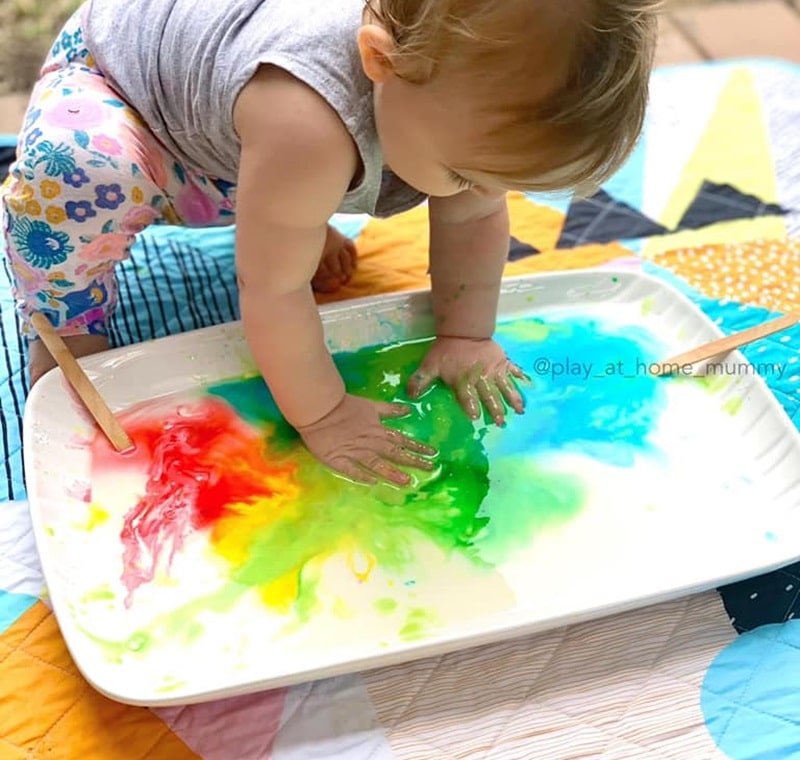 |
| Image: Play At Home Mummy |
The really fun thing about oobleck is that it's a non-Newtonian fluid meaning it can behave as both a solid or a liquid. When it is squeezed under pressure it will act as a solid, however if you open your hand it will turn back into a liquid and flow through your fingers. This is a great sensory texture for babies to explore and is taste safe if they happen to lick their fingers.
Chickpea foam
Chickpea foam {also known as aquafaba} is a taste safe foam with a similar fluffy texture to whipped cream, but none of the sugar. Chickpea foam can be made using the liquid from a can of chickpeas and some cream of tartar. You can also add in food colouring or some plastic toys to make it more inviting.
Chia seed slime
Chia seeds are another taste safe sensory bin option, however they will need to be prepared ahead of time as they need to soak in the fridge. Once they've soaked and expanded they'll turn into a slimy gel type consistency that's super fun to play in. Be warned though this one can also get very sticky and messy.
Please note that chia seeds can and will stick to clothing very easily so I recommend using an art smock and waiting until the seeds have dried then flicking them off, rather than washing clothes to remove them. Also if you do this activity outside and wash the chia onto the grass after play, you may notice a little chia seed patch sprout up a few days later.
Oat sensory bin
If you want a super simple taste safe sensory bin that requires pretty much no prep, try this oat sensory bin. I just poured some plain oats into a tray then added some of the kitchen items from our play kitchen {so they were smaller and easier for her to hold} so she could scoop, mix and pour the oats.
Even though this one is taste safe, plain oats aren't really that flavoursome so it's unlikely that they'll be wanting to eat it. You can also dye oats with food colouring if you want to.
Rainbow spaghetti
Rainbow spaghetti is another fun taste safe option for babies to explore as cooked spaghetti has a soft, squishy texture and can be easily manipulated. You can make rainbow spaghetti by following these instructions. If you know or suspect your baby has a gluten intolerance you can use gluten free spaghetti.
Disclosure - This post contains some affiliate links for your convenience, which means I may make a small commission at no cost to you, should you make a purchase.




